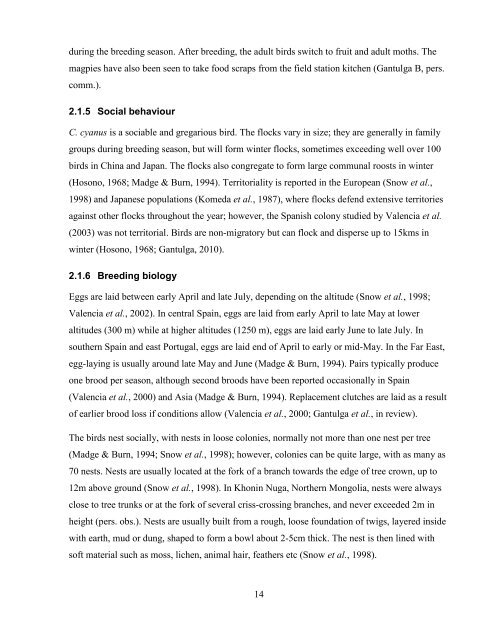Habitat use and population dynamics of the Azure-Winged Magpie ...
Habitat use and population dynamics of the Azure-Winged Magpie ...
Habitat use and population dynamics of the Azure-Winged Magpie ...
You also want an ePaper? Increase the reach of your titles
YUMPU automatically turns print PDFs into web optimized ePapers that Google loves.
during <strong>the</strong> breeding season. After breeding, <strong>the</strong> adult birds switch to fruit <strong>and</strong> adult moths. The<br />
magpies have also been seen to take food scraps from <strong>the</strong> field station kitchen (Gantulga B, pers.<br />
comm.).<br />
2.1.5 Social behaviour<br />
C. cyanus is a sociable <strong>and</strong> gregarious bird. The flocks vary in size; <strong>the</strong>y are generally in family<br />
groups during breeding season, but will form winter flocks, sometimes exceeding well over 100<br />
birds in China <strong>and</strong> Japan. The flocks also congregate to form large communal roosts in winter<br />
(Hosono, 1968; Madge & Burn, 1994). Territoriality is reported in <strong>the</strong> European (Snow et al.,<br />
1998) <strong>and</strong> Japanese <strong>population</strong>s (Komeda et al., 1987), where flocks defend extensive territories<br />
against o<strong>the</strong>r flocks throughout <strong>the</strong> year; however, <strong>the</strong> Spanish colony studied by Valencia et al.<br />
(2003) was not territorial. Birds are non-migratory but can flock <strong>and</strong> disperse up to 15kms in<br />
winter (Hosono, 1968; Gantulga, 2010).<br />
2.1.6 Breeding biology<br />
Eggs are laid between early April <strong>and</strong> late July, depending on <strong>the</strong> altitude (Snow et al., 1998;<br />
Valencia et al., 2002). In central Spain, eggs are laid from early April to late May at lower<br />
altitudes (300 m) while at higher altitudes (1250 m), eggs are laid early June to late July. In<br />
sou<strong>the</strong>rn Spain <strong>and</strong> east Portugal, eggs are laid end <strong>of</strong> April to early or mid-May. In <strong>the</strong> Far East,<br />
egg-laying is usually around late May <strong>and</strong> June (Madge & Burn, 1994). Pairs typically produce<br />
one brood per season, although second broods have been reported occasionally in Spain<br />
(Valencia et al., 2000) <strong>and</strong> Asia (Madge & Burn, 1994). Replacement clutches are laid as a result<br />
<strong>of</strong> earlier brood loss if conditions allow (Valencia et al., 2000; Gantulga et al., in review).<br />
The birds nest socially, with nests in loose colonies, normally not more than one nest per tree<br />
(Madge & Burn, 1994; Snow et al., 1998); however, colonies can be quite large, with as many as<br />
70 nests. Nests are usually located at <strong>the</strong> fork <strong>of</strong> a branch towards <strong>the</strong> edge <strong>of</strong> tree crown, up to<br />
12m above ground (Snow et al., 1998). In Khonin Nuga, Nor<strong>the</strong>rn Mongolia, nests were always<br />
close to tree trunks or at <strong>the</strong> fork <strong>of</strong> several criss-crossing branches, <strong>and</strong> never exceeded 2m in<br />
height (pers. obs.). Nests are usually built from a rough, loose foundation <strong>of</strong> twigs, layered inside<br />
with earth, mud or dung, shaped to form a bowl about 2-5cm thick. The nest is <strong>the</strong>n lined with<br />
s<strong>of</strong>t material such as moss, lichen, animal hair, fea<strong>the</strong>rs etc (Snow et al., 1998).<br />
14

















